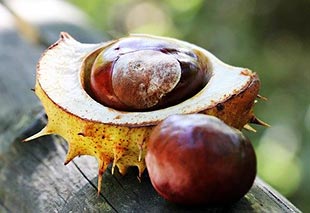Anyone who has visited Europe in the winter will recall the aroma of roasting chestnuts in the cities, the European variety known as Sweet or Spanish, originated in Asia Minor. 3,000 years ago the Greeks began growing the trees, and as the Romans conquered the known world, they spread chestnut cultivation throughout Europe and England. Before the arrival of potatoes from the New World, chestnuts were a staple in the European diet, providing the basic starch for the poor. Wild chestnuts were ground into flour to make bread in regions where the soil was poor.
Varieties of Chestnuts
Today mostly the Chinese variety is cultivated in North America, but those found in stores are usually imported from Europe. Grafting techniques and hybrids are allowing some competition for the domestic market. There are two types of chestnut. The Marron, the finest variety, has one nut in each husk, and the common domestic chestnut, or Chataigne, has two to three nuts in each husk. Don’t confused either with the common, inedible Horse Chestnut. The biggest and best of the Marrons become the famous Marrons Glacés – chestnuts candied in sugar syrup – a popular Christmas gift.
Selection and Storage
Choose large heavy chestnuts with smooth glossy shells. Look carefully to make sure there is no mould. Watch out, too, for tiny holes-they indicate bugs. Stored in an airtight container in the refrigerator, they will last several weeks. Two lbs (1 kg) fresh chestnuts equals 1 lb (500 g) shelled or about 2 cups (500 mL).
Prepartion
Chestnuts take time to prepare-they have a glossy shell and secondary skin that are difficult to remove. Before cooking, make a slit in the shell or else they will explode. The best tool for this is a Stanley knife (available at hardware and art stores). Make a slit around the middle circumference of the nut. Place four to five nuts at a time into boiling water. Boil five to ten minutes, then remove one at a time. Remove both layers while the nut is still hot. If the second skin is difficult to remove, return to boiling water for several more minutes.
How to Roast Chestnuts
Make a slit in the nuts as described above and place in a 350SF (1 80′ C ) oven for about 20 minutes or until shells crack open. Remove and wrap in a towel for 5 minutes. Peel and serve sprinkled with a little sea salt. To roast in a fire, take an aluminum pie plate and punch rows of holes. Make cuts in chestnuts or puncture them to release steam and place on a grill over white hot coals. If you have a chestnut roaster for the fireplace, all the better.
Chestnut Products
Chestnuts can be found dried, canned or vacuum-packed (the latter is the best substitute for fresh). When buying the canned product read the label-some are packed in syrup and purées are not always pure, containing corn syrup, and vanilla . Chestnut flour is available in specialty stores and is used as a thickener and in some Italian pastas and desserts.
How to make Marrons Glacés
Marrons glacés are chestnuts which are candied in a syrup solution and then dried. They are extremely popular in France, a nation of avid chestnut consumers, and they can be found in other regions of the world as well, especially during the holiday season.
A true marron glacé takes several days to cook from start to finish, making it an expensive delicacy, although some people cheat on the cooking process; fans of this traditional French food claim to be able to taste the difference. The recipe for the marron glacé appears to have emerged in the 16th century, around Lyon.
To make this dish, chestnuts are peeled and blanched to remove their fibrous membranes before they are soaked in a sugar syrup. The syrup and chestnuts are periodically heated to encourage absorption of the syrup, and when all of the syrup has evaporated or been absorbed, the chestnuts are dried. The finished product is a chestnut with an outer coating of sugar and a rich, candied interior. A marron glacé can be a delicious food as-is, and these candied chestnuts are also used as garnishes on desserts, especially during the holidays.
To make marrons glacés, start by peeling around two and a half pounds (one kilogram) of chestnuts, and then blanch them in lightly salted water to loosen their membranes. Peel the membranes off the chestnuts, discarding the water, and set them aside. In a heavy saucepan, heat one quart (one liter) of water along with two heaping cups of sugar and a crushed vanilla bean until all of the sugar has dissolved, and then simmer for five minutes. Add the chestnuts, bring the mixture to a boil, and cook for 10 minutes. Then cover the saucepan and allow it to sit undisturbed for 12 hours.
After 12 hours, heat the mixture again, bringing it to boiling for one minute and then covering the saucepan and allowing it to sit for 24 hours. At the end of this time period, heat again, hold at boiling for a minute, cover, and let sit for 24 hours again.
Repeat this process until all of the syrup has been absorbed, and then lay the marrons glacés out to dry in a warm oven. Allow them to cool completely.
Our Top 10 Recipes Using Chestnuts
in no particular order…
- Chestnut Cake
- Chestnut and Bacon Risotto with Savoy Cabbage
- Tagliatelle with Chestnuts, Pancetta, and Sage
- Sherried Chestnut Soup
- Stuffing made with Ciabatta, Chestnuts and Pancetta
- Belgian Endive “Boats” with Marinated Chestnuts and Parma Ham
- Cabbage and Chestnut Soup
- Pork Roast with Apple Chestnut Stuffing
- Potato-Chestnut Puree
- Chestnut Pancakes with Bacon and Crème Fraîche
Image by S. Hermann & F. Richter from Pixabay pixabay.com/photos/chestnut-autumn-spur-open-1698741/



